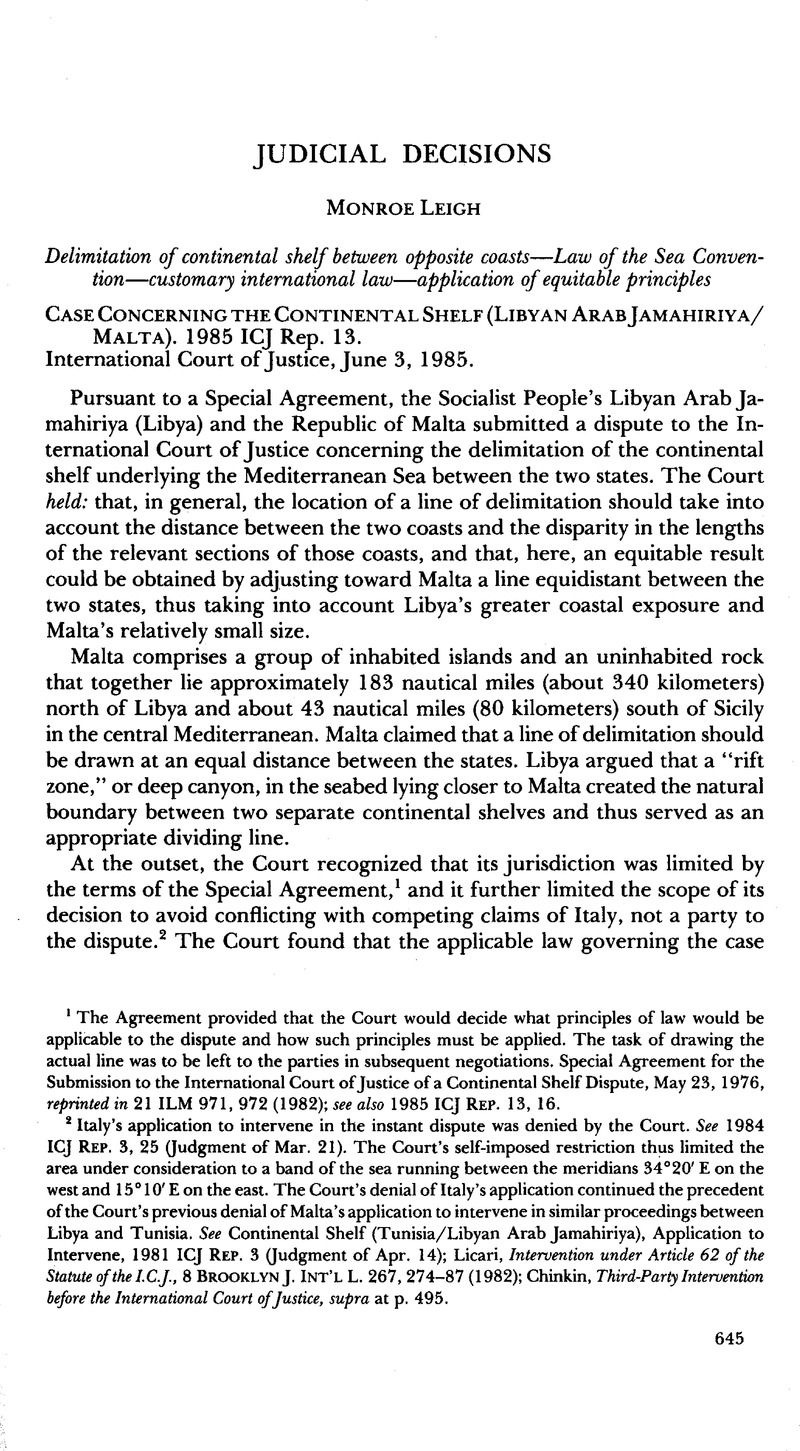Published online by Cambridge University Press: 27 February 2017

1 The Agreement provided that the Court would decide what principles of law would be applicable to the dispute and how such principles must be applied. The task of drawing the actual line was to be left to the parties in subsequent negotiations. Special Agreement for the Submission to the International Court of Justice of a Continental Shelf Dispute, May 23, 1976, reprinted in 21 ILM 971, 972 (1982); see also 1985 ICJ Rep. 13, 16.
2 Italy’s application to intervene in the instant dispute was denied by the Court. See 1984 ICJ Rep. 3, 25 (Judgment of Mar. 21). The Court’s self-imposed restriction thus limited the area under consideration to a band of the sea running between the meridians 34°20’ E on the west and 15°10′ E on the east. The Court’s denial of Italy’s application continued the precedent of the Court’s previous denial of Malta’s application to intervene in similar proceedings between Libya and Tunisia. See Continental Shelf (Tunisia/Libyan Arab Jamahiriya), Application to Intervene, 1981 ICJ Rep. 3 (Judgment of Apr. 14); Licari, , Intervention under Article 62 of the Statute of the I.C.J. , 8 Brooklyn J. Int’l L. 267, 274–87 (1982)Google Scholar; Chinkin, , Third-Party Intervention before the International Court of Justice , supra at p. 495 Google Scholar.
3 This finding flowed from the fact that there were no relevant treaties claimed to be binding on the parties. The Court accorded major importance to the 1982 United Nations Convention on the Law of the Sea (opened for signature Dec. 10, 1982, reprinted in United Nations, Law of the Sea: United Nations Convention on the Law of The Sea (UN Pub. Sales No. E.83.V.5)), because, even though the Convention had not yet entered into force, both parties had signed it and it had been signed by an overwhelming majority of states. The Court noted, however, that while the Convention set a goal that the delimitation of disputed areas of a continental shelf is to be decided on an equitable basis, the Convention is silent as to the method to be followed to achieve this goal.
4 1985 ICJ Rep. at 31.
5 Id. at 35. The Court also rejected Libya’s argument that the rift zone in the seabed nearer to Malta than to Libya marked a tectonic plate boundary between the two states, which thus constituted a physical discontinuity so fundamental between the two states that it should serve as a legal discontinuity as well. The Court observed that the data available to prove or disprove the hypothesis advanced by Libya were insufficient to form a legal basis for title. Id. at 36. See also Continental Shelf (Tunisia/Libyan Arab Jamahiriya), 1982 ICJ Rep. 18, 57 (Judgment of Feb. 24).
6 1985 ICJ Rep. at 37.
7 The Court reached this conclusion by first drawing an imaginary median line between Italy and Libya as if Malta did not exist. It then concluded that, since Malta does exist, the proper line of delimitation between it and Libya had to be somewhat south of the Italy-Libya median line. It reasoned that Malta, as an independent state, and not just a part of Italy, must have some rights to the continental shelf over and above those that Italy could assert. Id. at 51–52.
8 Id. at 52. The Court gave no reason why the line was moved three-quarters of the way north, as opposed to a different fraction, other than to note that some fraction had to be chosen and that the task it had assumed could not be infallibly reduced to a formula. Id.
9 See id. at 117 (Mosler, J., dissenting); id. at 131 (Oda, J., dissenting); id. at 173 (Schwebel, J., dissenting).
10 Id. at 114–22 (Mosler, J., dissenting).
11 Case Concerning the Delimitation of the Continental Shelf between the United Kingdom of Great Britain and Northern Ireland, and the French Republic, Decision of 30 June 1977, 18 R. Int’l Arb. Awards 3, reprinted in part in 1985 ICJ Rep. at 144–48 (Oda, J., dissenting).
12 1985 ICJ Rep. at 139.
13 Apr. 29, 1958, 15 UST 471, TIAS No. 5578, 499 UNTS 311.
14 Delimitation of the Maritime Boundary in the Gulf of Maine Area (Can. v. U.S.), 1984 ICJ Rep. 246 (Judgment of Oct. 12). In Gulf of Maine, the Chamber roughly denned the disputed area—the seabed of the Gulf of Maine between the northeastern coast of the United States and the coast of Nova Scotia—as an open rectangle lying northeast to southwest, with the northwest corner approximately coinciding with the international boundary between the two countries and with one of the long sides opening out to the Atlantic Ocean. The Chamber fashioned a line of delimitation in three segments. The first segment emanated from a point near the northwest corner of the rectangle and proceeded out into the Gulf, bisecting the angle of that corner. The second and third segments proceeded out of the Gulf into the Atlantic, perpendicular to the open face of the rectangle and slightly nearer to Nova Scotia to account for the disparity of lengths of coastlines of the two countries in the relevant areas. See id. at 335–38.
15 1985 ICJ Rep. at 169.
16 Id. at 186–87.
17 See, e.g., North Sea Continental Shelf Cases (FRG/Den.; FRG/Neth.), 1969 ICJ Rep. 3 (Judgment of Feb. 20); Continental Shelf (Tunisia/Libyan Arab Jamahiriya), 1982 ICJ Rep. 18; Delimitation of the Maritime Boundary in the Gulf of Maine Area (Can. v. U.S.), 1984 ICJ Rep. 246.